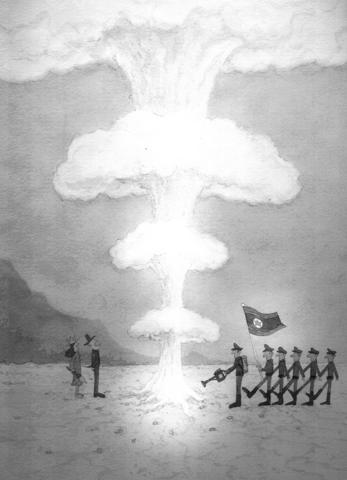A flurry of news dispatches from the Korean Peninsula over the last 10 days has provided fresh evidence that things are spiraling toward chaos at that end of President George W. Bush's "axis of evil."
US relations with South Korea continued to slide downhill with Seoul's publication of a strange "white paper" on defense.

ILLUSTRATION: MOUNTAIN PEOPLE
North Korea asserted that it has actually produced nuclear weapons and, by refusing to continue negotiations, showed that it has no intention of giving up its nuclear ambitions.
In the first case, South Korea's Ministry of National Defense alleged that, in the event of hostilities with North Korea, the US would deploy 690,000 troops, 2000 warplanes, and 160 warships to the defense of South Korea.
That statement was absurd on the face of it. The 690,000 troops would require sending the entire US Army and the entire US Marine Corps to Korea, leaving all other missions to the National Guard and Reserves. The 2000 warplanes would be more than three times the aircraft assigned to the Pacific Air Forces. The 160 ships would be about half of the US Navy.
This claim, which was presumptuous, not to say bizarre, implied that the government of President Roh Moo-hyun could not deal with the implications of the US decision to reduce its forces in South Korea and to revise the mission of those that remain. The primary task of the US forces will be to prepare for contingencies anywhere, not just to help defend South Korea.
The South Korean white paper indicated that Roh's defense ministry sought to assure South Koreans that the US would not abandon them. Ironically, that effort came atop rampant anti-Americanism in Seoul, an increasing tendency among young South Koreans to appease North Korea, and a growing South Korean preference for ties with China rather than the US.
As an Australian scholar and student of Northeast Asia put it, South Korean relations with the US are delicately poised between affirmation and severance.
An e-mail message to the defense ministry in Seoul seeking clarification was not answered by the time of this writing, which may have been because of a national holiday in South Korea. Even so, the defense ministry has not denied press reports that have been floating around for more than a week.
The ministry's English-language Web site announcing the release of its white paper did not mention the dispatch of US forces but focused on a change in terms. Instead of calling North Korea "the main enemy," the report noted North Korea's"conventional military power, weapons of mass destruction, and forward deployment of military forces." The headquarters of US Forces in South Korea professed to be unaware of the white paper despite articles in the South Korean press, the Associated Press, and on Chinese and Vietnamese TV news. "I have no information regarding this ROK document," said an officer speaking for the command. "However, as a matter of policy we do not discuss the contents or details of operational plans."
North Korea, along with Iraq and Iran, were included in the"axis of evil" by President Bush shortly after the terrorist assaults in New York and Washington on Sept. 11, 2001. By claiming that they have produced nuclear weapons, the North Koreans evidently sought to confirm what they had hinted at many times in the past. They also said they would not continue the six party talks intended to dissuade them from going nuclear. In those negotiations, the US, North Korea, South Korea, Japan, China, and Russia have held three previous meetings in Beijing.
Pyongyang claimed that North Korea has "manufactured nukes for self-defense to cope with the Bush administration's evermore undisguised policy to isolate and stifle the DPRK." The Democratic Peoples Republic of Korea is the official name of North Korea and "nukes" is slang for nuclear arms. The US has long contended that North Korea has nuclear weapons.
On negotiations, the North Koreans said: "We are compelled to suspend our participation in the talks for an indefinite period till we have recognized that there is justification for us to attend the talks and there are ample conditions and atmosphere to expect positive results from the talks." Whether that was a bargaining ploy remained to be seen.
Before its nuclear announcement, Pyongyang proclaimed: "If the US imperialists ignite flames of war, we will first of all strike all bases of US imperialist aggressors and turn them into a sea of fire." That thundering, too, repeated earlier belligerence.
Richard Halloran is a journalist based in Hawaii.
We are used to hearing that whenever something happens, it means Taiwan is about to fall to China. Chinese President Xi Jinping (習近平) cannot change the color of his socks without China experts claiming it means an invasion is imminent. So, it is no surprise that what happened in Venezuela over the weekend triggered the knee-jerk reaction of saying that Taiwan is next. That is not an opinion on whether US President Donald Trump was right to remove Venezuelan President Nicolas Maduro the way he did or if it is good for Venezuela and the world. There are other, more qualified
The immediate response in Taiwan to the extraction of Venezuelan President Nicolas Maduro by the US over the weekend was to say that it was an example of violence by a major power against a smaller nation and that, as such, it gave Chinese President Xi Jinping (習近平) carte blanche to invade Taiwan. That assessment is vastly oversimplistic and, on more sober reflection, likely incorrect. Generally speaking, there are three basic interpretations from commentators in Taiwan. The first is that the US is no longer interested in what is happening beyond its own backyard, and no longer preoccupied with regions in other
As technological change sweeps across the world, the focus of education has undergone an inevitable shift toward artificial intelligence (AI) and digital learning. However, the HundrED Global Collection 2026 report has a message that Taiwanese society and education policymakers would do well to reflect on. In the age of AI, the scarcest resource in education is not advanced computing power, but people; and the most urgent global educational crisis is not technological backwardness, but teacher well-being and retention. Covering 52 countries, the report from HundrED, a Finnish nonprofit that reviews and compiles innovative solutions in education from around the world, highlights a

Jan. 1 marks a decade since China repealed its one-child policy. Just 10 days before, Peng Peiyun (彭珮雲), who long oversaw the often-brutal enforcement of China’s family-planning rules, died at the age of 96, having never been held accountable for her actions. Obituaries praised Peng for being “reform-minded,” even though, in practice, she only perpetuated an utterly inhumane policy, whose consequences have barely begun to materialize. It was Vice Premier Chen Muhua (陳慕華) who first proposed the one-child policy in 1979, with the endorsement of China’s then-top leaders, Chen Yun (陳雲) and Deng Xiaoping (鄧小平), as a means of avoiding the